
Why You Need a Personal Financial Manager?
Personal finance management (PFM) is not confined to budgeting and investment any longer. There are
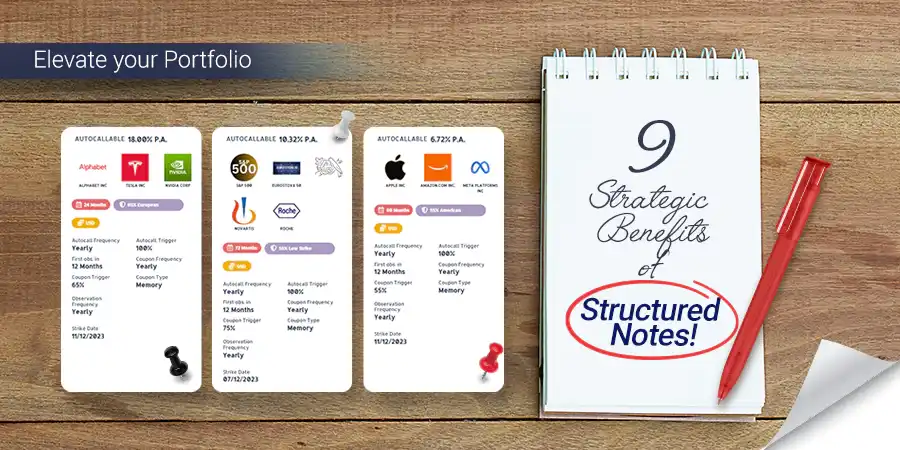
If you are thinking of investing, you must know about the different financial assets you can invest in. Presently, one of the most favorable ones is a structured note.
Apart from understanding the benefits of structured notes, we will know how they work and some of the misconceptions of structured notes as well.
A structured note is a debt security issued by many financial institutions worldwide.
And its target returns, unlike other financial securities, is based on multiple financial instruments like equity indexes, single equity, a basket of equities, interest rates, commodities, or foreign currencies.
The capital growth from the usage of structured notes allows protection against market fluctuations.
As a result of diverse underlying financial assets linked to the structured note, its performance is dependent on the return on an underlying asset, group of assets, or index.
It is a pre-diversified portfolio that ensures a balanced risk-return trade-off and thus, chances of getting into losses are reduced significantly.
And since structured notes are well-embedded with protection against market fluctuations, the returns are promising.
Structured Notes comprise diverse derivatives, one or more underlying assets, and fixed-income (bonds) investments.
The bond component of the structured note occupies the majority space of the investment and provides primary protection.
The rest of the area is taken up by other investment assets such as derivatives and underlying assets, offer investors upside potential.
In short, structured notes are customizable investment solutions that offer diversification, protection, and predictable returns and provide an alternative to traditional financial investments by providing protection against market fluctuations, making them a reliable investment option.
The purpose of a structured note is to provide an investment payoff that is attractive to protect investors and that is differentiated from returns available in simple equity and fixed-income markets.
You will learn the components of promising financial assets and the benefits of structured notes investment.
Plus you will get insights into how structured notes work, as well as addressing some misconceptions associated with them.
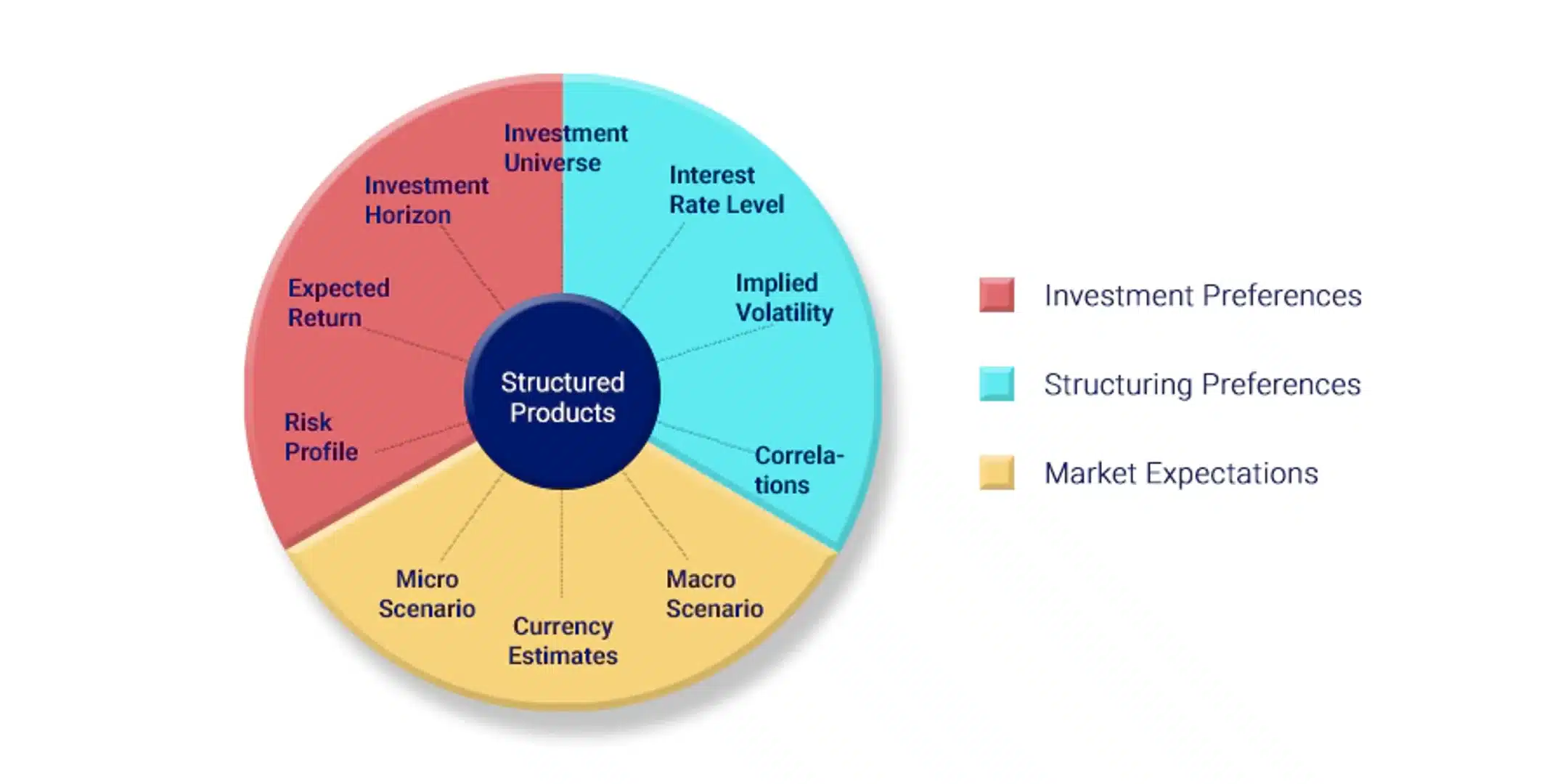
The three components of this promising financial asset are described below:
Depending on the investment goal of the structured note, the coupon generated with the aid of using the “Bond” component is used to buy the “derivative strategy” component and either provide the assured capital or enhance the return on a non-capital-guaranteed product.
The capital guarantee or safety is ensured by the issuer or its guarantor, except in the case of default.
Therefore, it becomes very crucial to test the rating attributed to the issuer by credit rating agencies.
The underlying asset adds to the improvement of the returns generated through investment.
The underlying component can be a single instrument or a basket of instruments.
These instruments include any asset class such as equity, debt, index, ETF, currency, or interest rate.
The “derivative strategy”, often consisting of options, is of acute importance in developing a structured note. It is often that this bond component marks the level of the returns.
The choice of derivatives will depend on:
● the risk appetite for the product,
● the desired investment horizon,
● the kind of return and exposure sought, and market conditions.
Every strategy, from the handiest to the most complex, is primarily based on the usage of derivatives, most frequently within the form of options.
A structured note, as mentioned above as well, is backed by several underlying assets.
As a result of the fusion of many underlying assets, there are different financial terms that operate to give the maximum benefits to the clients.
To name a few of them are autocall opportunities, memory coupon rate, capital risk, and capital protection barriers.
These features operate in accordance with the working of one another and deliver the best possible results.
Several wealth management companies provide multiple structured products.
With Quadra Wealth too, you get the promising benefits of structured notes from leading providers across the world.
You may view some of the current structured notes which are available for subscription. Each structured note has its specific currency, strike date, and maximum term.
It depends on the preferences, beliefs, and choices of the clients and which structured notes they opt for. Like the other financial securities have their advantages, structured notes too have their benefits.
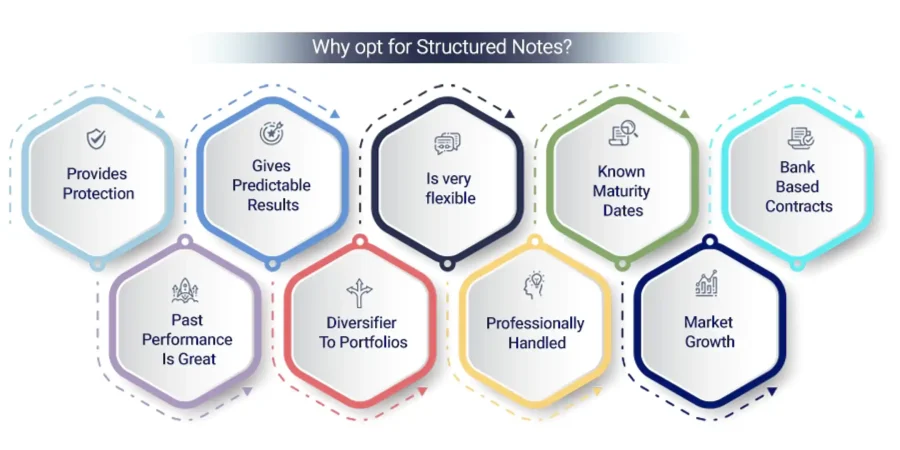
It’s probably the most critical and likable factor of a structured note. There are very few financial securities that provide protection against market fluctuations.
A well-structured note offers the maximum returns with the optimum level of protection which is guaranteed.
This protection assures a promising risk-adjusted return. Over the years, structured notes have developed so much that they can provide returns even if the market is in a declining phase.
For example, even if the market falls to 70% 50%, or 30%, investors need not worry because they will still get the returns.
Thus, a structured note provides excellent and reliable diversification in the investment portfolio.
Furthermore, it is a boon to those investors who feel very cautious when the market levels are down.
Structured notes are predictable investments because all the conditions that determine the outcome of a structured note are specified beforehand.
Although aspects like the underlying assets, issuing bank, barriers for protection, frequency, and coupon size are known, the market behavior of the underlying assets is highly unpredictable.
But it also doesn’t affect much because of the protection assured.
A few notes offer a low return on the investment with a negligible amount of risk. At the same time, others give a very high return even when the market is not performing well.
Thus, it is now possible to create a structured note using various financial instruments available today.
Though an ‘ideal’ structured note doesn’t exist, investors are encouraged to discuss the advantages of buying a specific structured note with their wealth managers.
As returns are pre-defined to be delivered on pre-defined dates, this helps significantly with your financial planning. With a growth product, this might be a set period over which returns are periodically generated.
At the same time, auto-calls can mature early on pre-set anniversary dates if certain conditions are met, for instance, when the index is greater than its initial investment.
And if investing in an auto-call, the potential of an early maturity makes the option of re-investment even more lucrative.
While banks have not always been given the best press and results, it cannot be ignored that they have a solid spine of regulatory action to support their balance sheets and are in a lot better condition than before the financial crisis.
So, it is relieving for some investors to have banks backing their financial decisions.
Especially, the retirees and would-be retirees, who have been more prone to traditional financial systems.
Structured products have proven to be very trustworthy again and again because they do what they say, no matter what.
They have delivered a consistent performance with perfect finesse.
There are active funds governed by professionals who take high risks to outperform the market. And then, there are passive investments that go according to the market.
And then comes the structured notes, which provide good returns with adequate capital and market protection.
We may conclude that structured products are an excellent diversification to an investment portfolio.
Putting all your eggs in one basket has never been a good decision, in any walk of life. And in the case of investment too, this applies with 100% accuracy.
With a combination of such investment assets that diversify the set of risks and generate higher returns, one is highly likely to get the expected results irrespective of the direction of the market to some extent.
A positive return from investing in equity markets often relies on the growth in the equity underlying the investments.
Whereas, in general, a structured note needs the underlying asset allocation on a pre-set date to be greater than the initial level to have profits on maturity.
Therefore, structured products can make a gain even in a flat or only slightly rising market.
Structured Notes are highly efficiently managed by banks and wealth managers.
It also assists in meeting the objective of the investors and minimizes the risks involved.
Structured products confirm that one meets their aspirations even during a bad market phase.
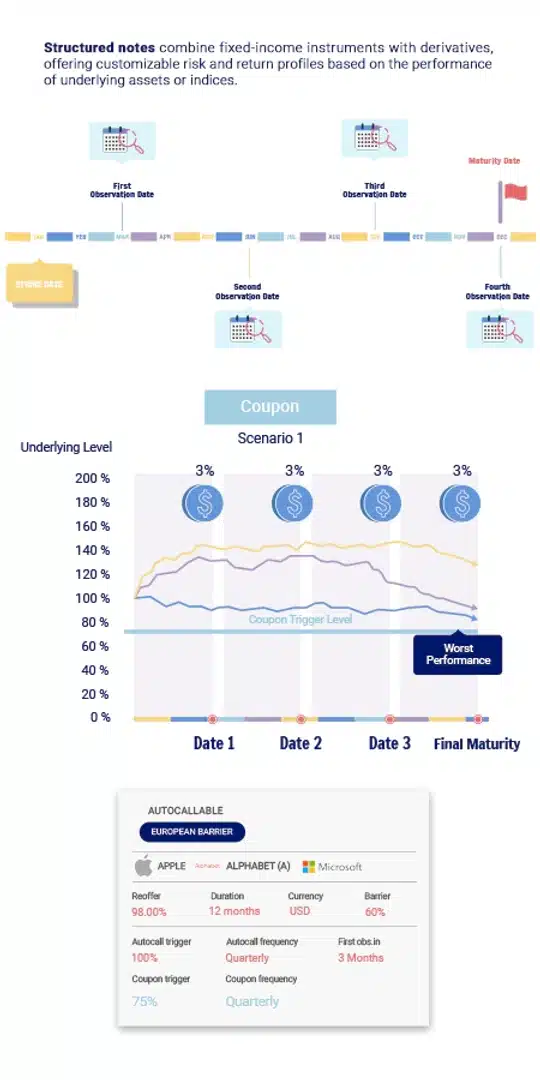
Structured products include traditional instruments like bonds but the entire bundle is designed so that underlying assets like derivatives etc, substitute the regular returns from bonds.
The working of a structured product is explained below with the help of an example:
Suppose you have invested $100 in a structured product.
The capital is preserved for five years. Subsequently, you will be getting your initial invested amount($100) after maturity (on finishing the 5-year period) in addition to the returns generated by the underlying assets.
Thus, in this case, $80 will be invested in bonds whose maturity value would be up to $100 (after 5 years).
This is due to the fact the fund manager is bound to preserve your capital and therefore invests in fixed coupon debentures.
Debentures are money borrowed by companies on the promise of reimbursement with interest.
They provide coupons to the investors known as coupon debentures.
Lastly, the final returns on the structured products would depend upon the overall performance of the index.
In case the performance is positive, there would be a total return plus capital. And if the performance is negative, only capital will be given back.
You may check the currently structured notes available for subscription.
Sales of structured products started in the 1980s. The products acquired popularity with institutional investors in 1990.
More recently, members have reported that structured products have been increasingly targeted at retail investors.
Many of the structured products oriented towards retail investors are based upon “blue-chip” and “household-name” stocks with the global most common indices.
Structured notes can also be an efficient device for making an investment in all asset classes, consisting of fragmented or difficult-to-get admission to markets, with tailored protection.
Without a doubt, as investment answers in their very own right, structured notes constitute an authentic and adequate opportunity for standard financial investments.
They provide solutions that may be adapted to the desires of each investor, for instance in terms of approach, risk/ return profile, maturity, or the amount to be invested.
They enable investments in an extensive variety of underlying assets (equities, interest rates, foreign exchange, indices, commodities) and offer diverse redemption possibilities.
Structured notes can consequently provide solutions keeping in mind the market conditions. Even if they are well-protected assets, they can be complicated.
This complication is required to satisfy the investors who have their own investment profile and necessary knowledge of the market.
Moreover, structured note-issuing companies, take care of the compliance of structured products with the respective regulatory authorities.
Using various financial instruments, multiple wealth management companies have developed advanced capabilities and adequate compliance to offer their clients the best investment/ wealth management solutions.
These derivative-linked products and structured deposits are for clients seeking to manage charges and receive a return on their liquidity through investing their money or via derivatives-linked techniques that are structured and documented.
Thus, it is a suitable financial instrument for global citizens, especially in a city like Dubai.
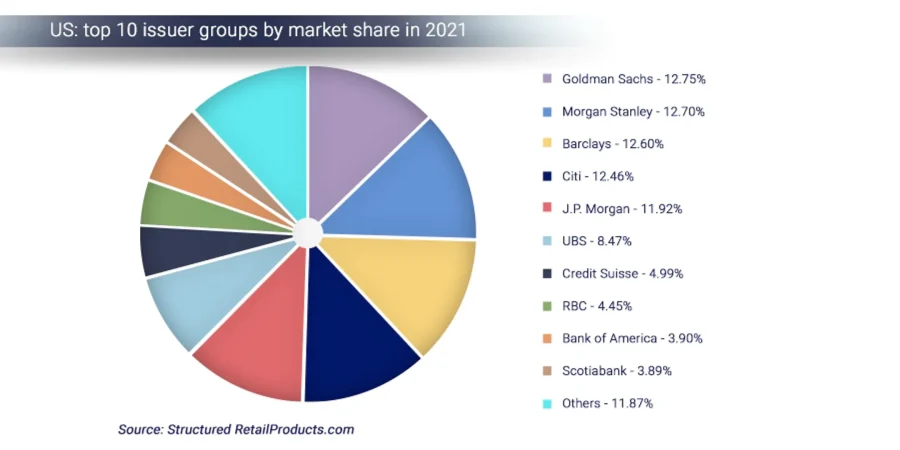
However, despite the most sought-after advantages in any financial asset, which is undoubtedly present in structured products.
People have many misconceptions regarding them. Some of them are:
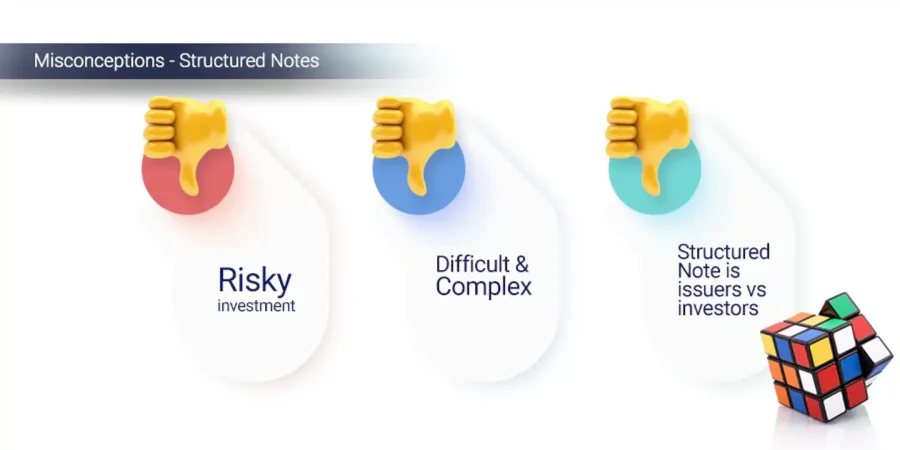
Like any investment present, there are different kinds of structured notes with varying degrees of risk.
Some structured notes may be risky whilst others have a risk profile more like that of bonds, with features and principal protection.
Specific structured notes are designed to be riskier investments because they are orientated to have a better potential payoff.
However, the thing about structured notes is, that they usually include the built-in level of downside protection.
So, people prefer well-protected structured notes in contrast to owning stock.
Thus, structured notes act as a well-cushioned against risks middle ground between stocks and bonds.
The next misconception we frequently hear is that structured notes are too challenging and complicated to understand.
But to a certain degree, this can be managed with deep knowledge and education. Before investing with structured notes, the primary task is to understand portfolio objectives.
Then the structured notes can be used for many purposes such as capital protection, upside participation, or output enhancement.
Learning how a bond works and adding an options overlay are the building blocks of beginning to apprehend how a considerable majority of structured notes function.
One of the most common misconceptions is that banks are making a bet against people who purchase structured notes.
Generally speaking, banks aren’t in the business of taking huge positional bets on the markets; rather they prefer to be in the more secure business of collecting fees.
Banks get paid an advance fee to create and issue structured notes; that’s part of the transaction cost. And that’s where banks need to make their money.
Since most of the structured notes are inclined to surpass the stock market, if banks did not hedge their risk, they would all be below the stock market, collectively – obviously, it is not something they want to do regularly (if ever).
Structured note issuers want to issue cheap debt, earn an affordable fee for creating the customized investment, and see the client satisfied with the result.
In other words, it’s very possible that both the issuing bank and the note buyer make money on the trade. This is how a healthy market should work in the ideal case.
Thus, this integrated investment solution is highly customizable and can offer efficient diversification to your investment portfolio.
Considering the aforesaid points, the investor can invest in structured notes at their convenience.
Investors don’t have to mind-boggle over tiny details of market fluctuations. Trusting returns also ensures financial stability in their lives.

As structured notes are complex financial products, a simple definition of how it works is these investments are debt securities that are issued by financial institutions. And a structured note is a personalised product that can be created for any investment goal by using four main building blocks. The return on a structured note investment is linked to an underlying asset or group of assets. This value of the underlying assets could comprise stocks, commodities, interest rates, or currencies.
Structured notes have three main components: the bond component, the underlying component, and the derivative component. The bond provides primary protection, the underlying asset affects the returns, and the derivative strategy influences the level of returns.
Like any investment, structured notes can have varying degrees of risk. However, structured notes often include built-in downside protection, making them a middle ground between stocks and bonds in terms of risk.
While structured notes can be complex, education and knowledge can help investors understand them better. Learning about portfolio objectives and the basic workings of bonds and options can provide a foundation for understanding structured notes.
Yes, structured notes are increasingly targeted at retail investors. They can be customized to suit individual investor needs, offering solutions that align with their risk appetite, return expectations, and investment preferences.
Investors can typically invest in structured notes through wealth management companies and financial institutions. Consultation with a wealth manager can help identify suitably structured notes based on individual investment goals and preferences.

Personal finance management (PFM) is not confined to budgeting and investment any longer. There are

Nearing retirement advice? A plan for retirement is essential to enjoy a happy healthy life

What is Debt Ceiling? Debt Ceiling, also known as the debt limit, is the highest

Debt is often considered the norm in the corporate world, but the debt free companies
Quadra Wealth Investment Advisor LLC is an independent offshore financial planning and wealth management advisory firm based out of Sharjah, UAE. We specialize in wealth management services, not limited to retirement planning, children’s higher education plans and wealth accumulation plans.

Quadra Wealth Investment Advisor LLC is an independent offshore financial planning and wealth management advisory firm based out of Sharjah, UAE. We specialize in wealth management services, not limited to retirement planning, children’s higher education plans and wealth accumulation plans.
